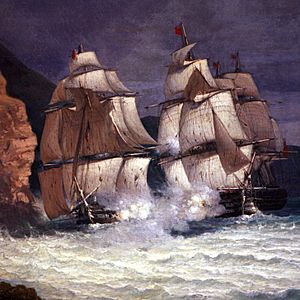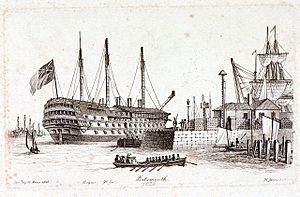HMS Boyne (1810) facts for kids

Fight of the Romulus against HMS Boyne and HMS Caledonia, by Vincent Courdouan (1848)
|
|
Quick facts for kids History |
|
|---|---|
| Name | HMS Boyne |
| Ordered | 25 June 1801 |
| Builder | Portsmouth Dockyard |
| Laid down | April 1806 |
| Launched | 3 July 1810 |
| Renamed | HMS Excellent, 1834 |
| Fate | Broken up, 1861 |
| General characteristics | |
| Class and type | Boyne-class ship of the line |
| Tons burthen | 2155 bm |
| Length | 186 ft (57 m) (gundeck) |
| Beam | 51 ft 5 in (15.67 m) |
| Depth of hold | 22 ft (6.7 m) |
| Propulsion | Sails |
| Sail plan | Full-rigged ship |
| Complement | 738 (650 razeed) |
| Armament |
|
HMS Boyne was a 98-gun second rate ship of the line of the Royal Navy, built by Nicholas Diddams at Portsmouth Dockyard and launched on 3 July 1810 at Portsmouth. On 12 February 1814 she took part with HMS Caledonia in a hot action against the French line-of-battle ship Romulus off Toulon; the French 74 managed to escape to Toulon by sailing close to the coast to avoid being surrounded. With the 1817 changes to the rating system Boyne was rerated as a 104-gun first rate ship.
On 23 November 1824, Boyne was driven ashore at Portsmouth during a gale. In 1826 she was cut down (razeed) to become a two-deck, 76-gun third-rate ship of the line. On 1 December 1834 she was renamed HMS Excellent and became a training ship. On 22 November 1859 she was renamed HMS Queen Charlotte and paid off the following month before being broken up from December 1861.


